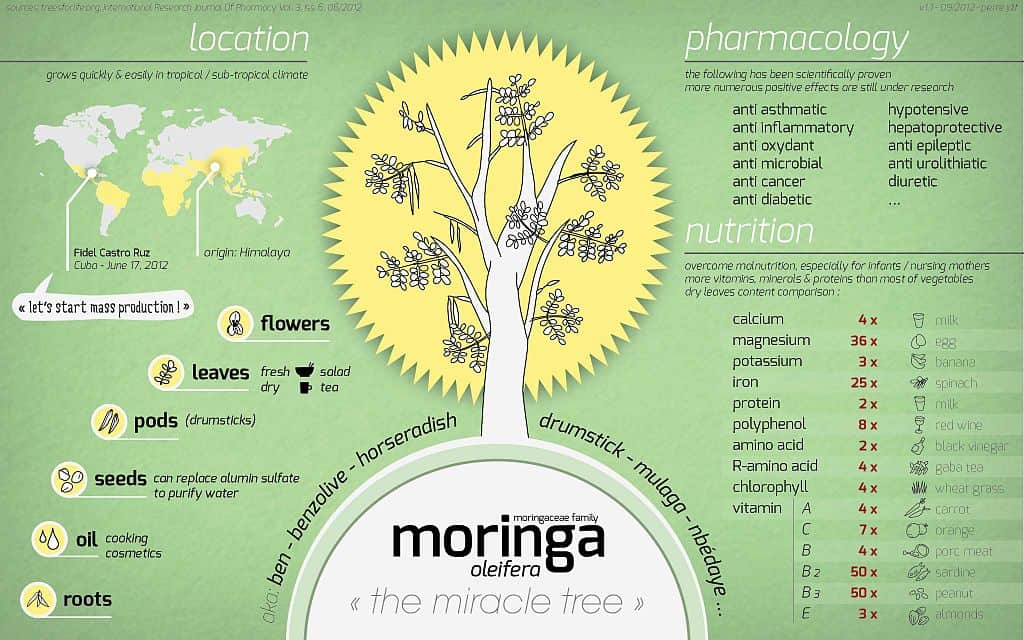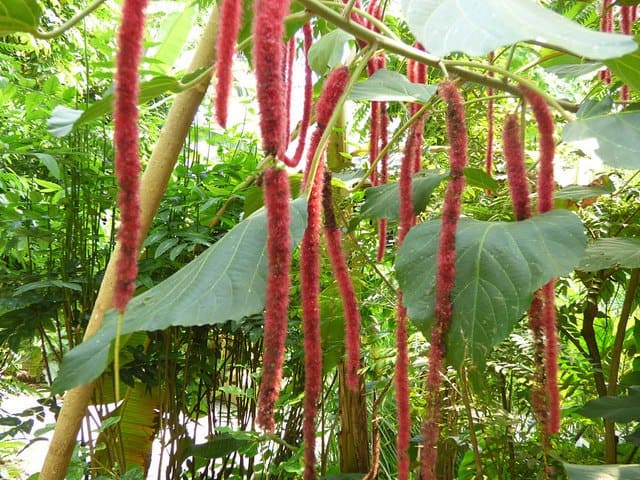Grow Moringa Trees for your Health!
Grow with Confidence by following our easy instructions below.
If you’ve read an article about the amazing health benefits of this ‘vitamin tree‘ then you’ve probably though about trying your hand at growing a Moringa tree yourself. In this helpful article, we’ll give you detailed information and everything you need to know to get started growing Moringa.
Let’s jump right into the article with a table of contents to help you find the exact information you’re looking for in this article fast.
Article Table of contents – Getting Started:
- General Information on Moringa Plants
- Cultivation and Growing Environment Information
- Planting Moringa from Seeds
- Growing from Root Cuttings
Article Table of contents – Ongoing plant care needs and Moringa nutritional information:
Or skip this article content and buy the comprehensive guide to growing Moringa trees on Amazon:
General Plant Information
The Moringa tree [common name] can be found growing in the ground in parts of Asia, Africa and South America today, but they are native to northern India. This plant has also been referred to as the horseradish tree, ben oil tree or the drumstick tree, but the scientific name is moringa oleifera. Many are aware of the plant’s well-known health benefits and it’s considered to be in the list of ‘superfoods’ by many.
The leaves, seeds and young seed pods are edible, and it’s known for cleaning up toxins and impurities along with being a superior source of vitamins and nutrients.
Moringa has been used for centuries due to its nutritional profile, antiviral, antifungal, and antidepressant properties. A Healthline article lists these 6 surprising benefits to adding Moringa leaves into your diet:
- Nutrition Boost – A Good Source of A, C and B Vitamins
- Antioxidants like Quercetin and Vitamin C
- Lower Blood Sugar Levels
- Reduced Inflammation
- Lower Cholesterol
- Protection Against Arsenic Toxicity
The tree’s recent popularity came about because it’s been used to provide missing nutrients in diets all over the 3rd world due to it’s rapid growth and helpful affordability. Moringa farms and nurseries are starting to become commonplace in many regions, as more people are becoming aware of this amazing tree.
Now it’s one of the latest health trends in the US and fortunately, for all of you budget conscious health nuts in colder climates, Moringa trees can be grown easily in a pot indoors anywhere.

Original image source: https://en.m.wikipedia.org/wiki/File:Moringa.jpg
Cultivation and Growing Environment
Moringa trees do not survive frost, and are only suitable for year-round outdoor cultivation in USDA hardiness zones 9, 10 and some parts of zone 8 that do not experience freezing temperatures in any season. They do grow well in large containers indoors during the winter though. Moringa trees are prolific growers when they have the right environment, so you can also grow a new plant yearly from seed or cutting and expect a large yield.
Start in January or February (not August!) indoors and then move your Moringa plants outdoors [gradually!] after the last possible frost. You’ll have tall, bushy plants by August and you can relocate indoors by November or just start over with new seeds in the following year.
The seeds do not have a dormancy season requirement, so you can save them from your adult tree and replant seed pods immediately if you wish. Here’s a few specifics about the Moringa Tree you’ll need to know:
- Sunlight: A place with 6+ hours of full sun a day and the rest at least partial shade
- Ph range: 6.2-7.0
- Ideal temperature: 77-86 degrees F
- Common pests: pod fly, budworms and hairy caterpillars
- Common diseases: fruit rots, stem rot, root rot and stem canker
- Average growth: 3-5 meters per year!
As you can see, Moringa trees are one of the fastest growing biomasses on planet earth! Fortunately for us though, pruning them provides ingredients for tasty, healthy snacks like this Moringa chocolate energy bar you can try now while your plants are still growing.
Speaking of…here’s a few article tips and resources you might find useful to get started after you read the next section on planting:
Planting from seeds
Propagation from seed is very easy, but they do not take well to transplanting as saplings. So, opt for a large diameter container and plant seeds directly in a hole at a depth of about 1/2 inch in light, sandy soil. Germination can take from 3 to 14 days total. You can plant 3-4 seeds a few inches apart in the middle of your flower pot to make sure you have a successful attempt planted.
When they are 4-6 inches tall at the tip of the main stem, select the healthiest seedlings and gently remove the rest of the shoots. Check soil moisture levels every day, as you do not want the top few inches of soil mixture to completely dry out while your seedlings are taking root. Here’s a few options for buying Moringa seeds online:
Rooting Cuttings
If you either buy an established plant or get some seeds to take, you’ll have the ability to create an endless supply of Moringa saplings as clones! They’re extremely easy to grow from choice branch cuttings taken from your main tree trunk. Simply take a 6 foot branch and place it inside a 5 gallon bucket or larger size plant pots. These branches should root and begin growing in a few short weeks. Just keep them out of the sun and make sure they stay watered when you use this method.
Fill in loosely with a mix of sand and light loam soil. Water frequently to keep the soil moist while establishing your new cutting over the next few weeks. If you want to get a jump start and buy your branch cuttings online, we’ve compiled a few suggestions for buying Moringa branches online:
Soil and Water Requirements
The Moringa is a drought tolerant tree that loves sunlight. Once it’s roots have been established in the ground, it can tolerate breaks between rainfall events. But take care to water at least two times weekly and check the soils content for dryness every 2-3 days with new Trees. Mix 1 part sand with 9 parts potting soil for the ideal growing medium. Yes, you can fertilize immediately after planting, or simply add in .5 parts organic compost to the soil mix mentioned above.
- 1 Part Sand
- 9 Parts Potting Soil
- Compost [optional]
- Water Plant Weekly
Pruning and use
You’ll definitely want to enjoy the harvest and all the health benefits that come with adding the Moringa leaf to your diet! But it’s not just the foliage that’s edible! Did you know that the seeds are also edible? Simply peel back the pods outer layer and you can start with 2-3 seeds a day to see how your digestive system responds. The young seed pods will remind you of Asian snap peas if you cook them up in a wok with your favorite stir-fry recipes! Eating Moringa is anything but boring.
Moringa leaves can be added to just about any dish or juiced in your favorite fruit smoothie recipe. Eat them raw as sprouts in a salad or as a cooked green for variety. The nutrient value is off the charts with more Vitamin A in the form of beta-carotene than you’ll find in a carrot plus magnesium and lots of other important minerals.
You’ll have plenty each time you prune and harvest these prolific growers, so look up a good recipe or two.
You don’t have to be too specific with your pruning, so simply cut them to the desired width and height. Remember that you can usually get longer branches to take root if you want to clone a 2nd plant at this time. Here’s a few tools and resources you might find useful.
Fertilizer Products
Composted chicken manure seems to be the best option if you’re growing outdoors. For everyone else though, there’s no question that you’ll want to pick a fertilizer product with plenty of nitrogen and phosphorus to encourage them to grow. Also consider adding in some biochar, because these Moringa plants tend to respond well to this amendment.
As they survive in tropical climates with a lot of nutrient erosion, these trees typically require very little in the way of fertilizer. However, if you want a bumper yield from your homegrown Moringa, you might want to consider some of these products:
Fertilizing other plants? Believe it or not, many actually use Moringa leaves to make a sort of fertilizer tea that’s sprayed directly onto the leaves of other plants. So, add that to the list of potential uses below and you’ll know why keeping even one Moringa Tree around the house is so helpful.
Uses and Nutrition Info
Aside from the culinary uses we’ve already listed above, you can really take advantage of the nutritional profile of this plant! Dry some of your Moringa leaves for use as either an herbal supplement or make Moringa tea with them.
Yes, there’s even oils and salves made with Moringa, and you could easily start to DIY those products with your own ingredients at home. Here’s a few available products made from one of the ‘most nutritious plants on earth’.
Growing Moringa trees planted either at home or in a community garden, brings a lot of rewards with very little work, as these are easy to grow houseplants. A small amount of fertilizer and weekly watering is all it usually takes to see dense shoots emerge to turn your young saplings into established Moringa trees in no-time.
For the DIY gardener that’s also concerned about health, life and fitness, these trees really do pull double duty, so they belong at the top of your list of nursery plants to grow.
Looking for more guides or an article on plant care? Please check out a few more from our blog and thanks for reading this article!
Article by Fertilizer for Less.










